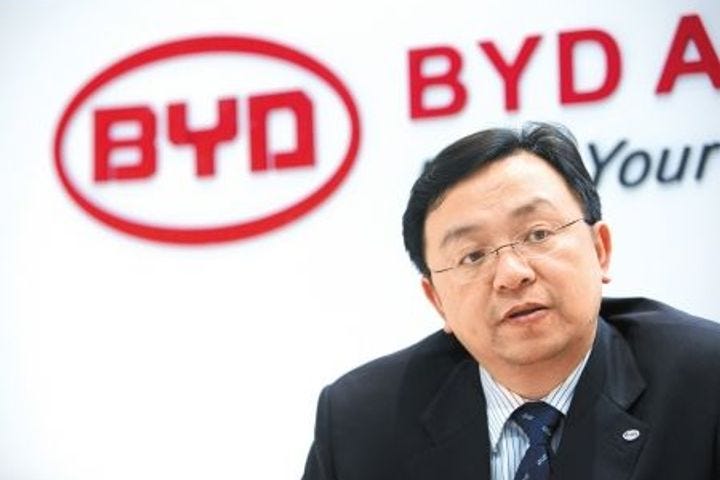How Did BYD Get So Good, So Fast?
Tesla, UAW, BYD, Lucid, Mexico, Liontown, Albemarle, GM, Volta, Robots
BYD: So Good, So Fast.
“We are not the same company you knew a few years ago,” a senior BYD executive said to me during a recent visit to HQ. “Now, we can compete anywhere.”
Hyperbole or fact?
Fact, apparently.
BYD is the world’s hottest car company. Sales are up 76% in 2023 and are on track to surpass Tesla. And BYD’s market capitalization ($94 billion) is greater than that of Ford and GM combined.
Now the Warren Buffett-backed company is pushing aggressively into global markets - from Spain to Australia to Thailand.
Germany and Japan, too.
Last week, BYD’s billionaire founder, Wang Chuanfu, took his private plane to Chile, Mexico and Brazil to examine fresh opportunities.
Most striking about BYD’s rise is the speed. How can a company go from less than half a million to 3 million deliveries in just three years?
BYD Sales 2019-2023
2019: 528,000
2020: 447,000
2021: 730,000
2022: 1.8M
2023: 3M (f)
As recently as 2019, BYD was still considered an also-ran in China’s car industry. BYD sales that year fell 10% – the second straight year of declines. The company acknowledged the poor performance in a statement to shareholders: “As subsidies on new energy vehicles drop sharply, sales of new energy vehicles are falling short of expectations.”
So, what secret ingredients have catapulted BYD into hyper-growth mode? And is it all sustainable?
Foundation. BYD’s industrial building blocks - batteries, motors and supply chains – had been in place for years. But demand for EVs remained stubbornly unenthusiastic throughout the 2010s.
Tesla Effect. When Tesla started manufacturing tens of thousands of Model 3s in Shanghai in early 2020, it had a profound positive effect on Chinese consumer perceptions of electric vehicles. Now, suddenly, electrics were the new cool. BYD, NIO, Li Auto and other Chinese EV makers benefited enormously from this shift in sentiment.
Design. BYD made the decision to hire highly talented designers like Wolfgang Egger from Audi to dramatically improve the look and feel of their vehicles.
So What, Now What
Today, BYD is the undisputed dominator of China’s EV industry, accounting for almost 40% of total EV production. It offers a complete range of vehicles from the $11,000 Seagull to the $48,000 Atto3 sedan to the $75,000 Tang SUV. And no one on the planet can match BYD when it comes to costs.
So, is there anything to stop BYD’s momentum? Two things to keep an eye on:
Market Access: BYD needs access to Western market for growth and profits. Political leaders in the US and Europe could adopt higher tariffs or quotas to blunt BYD’s export push. The EU Commissioner has already opened an anti-subsidy probe.
Long-term Reliability. It is hard for any company to grow at such a frantic pace without encountering some quality issues. Manufacturing hell did not go away.
Bottom Line
BYD Chairman Wang remains confident: “It is time for Chinese carmakers to upend the order of the global automotive industry and chart a course into a new vast territory.”
There is a good reason to take Wang’s words seriously. As Charlie Munger told Warren Buffet: “Wang Chuanfu is Thomas Edison, Henry Ford and Bill Gates all in the same person.”
Future Cars & Markets
Electrics
China Into Mexico. China is now the number one supplier of vehicles to Mexico. There are nine Chinese automakers selling in China, including BYD, Chery and SAIC MG. “The quality of Chinese vehicles has skyrocketed seemingly overnight.” Chery and BYD plan to build manufacturing plants to supply the US market. “It is a matter of when, not if.” Video
Lucid On the Ropes. What happens when you design and engineer a tremendous vehicle, but the price point is too high? Sales sputter and cash burn goes ballistic. That is the tough reality for Lucid leaders in 2023. Link
Volta Out. Sweden’s most promising electric truck maker is going out of business. The company says it had orders for more than 5,000 trucks but ran out of cash. Link
Batteries / Supply Chains
Another Advantage Tesla. We know that all EV batteries do not cost the same. Much depends on the size and chemistry. But this graphic gives us a clear picture of a battery’s share of the vehicle’s overall cost. More evidence that Tesla is steps ahead - at least outside of China.
Liontown Lithium. Tempted to invest in lithium? You’re not alone. Australia’s wealthiest woman, Gina Rinehart, just raised her stake in Liontown to 16.7%. It appears that Ms. Rinehart is “buying low” – lithium prices in China have fallen 70% this year - and knocking competitor bidder Albemarle out of contention. Link
Advanced Technologies
UAW Take Note: Robots Are Coming Fast. There are now more than 1 million robots working in the auto industry worldwide. Korea, Germany, the US and Japan use the most robots. But China is closing in quickly, accounting for more than 50% of new installations. Link
New Numbers / Milestones
1. Hello China 5 Million. Shipment of ICE-powered and battery-electric cars were up an explosive 50% again in September putting China on track surpass the 5 million mark in 2023. Russia and Mexico remain the largest destination markets. Link
2. EVs by Geography. As the people in Silicon Valley like to say: The future is already here, it is just unevenly distributed. Almost 25 percent of cars sold in California this year are battery electric. Make your way over to Ohio or West Virginia and the number drops to 1 percent.
Source: EVAdoption
Are Fuel Cell Vehicles Better Than EVs?
Charlie Freese, Executive Director, Global Fuel Cell Business, GM.
Listen to the Driving With Dunne podcast via Apple, Spotify, Amazon or wherever you take your podcasts.
The Dunne Insights Newsletter: Future. Electrics. Global.
Follow Dunne Insights on Twitter, LinkedIn and YouTube.
Visit: www.dunneinsights.com







